


9.4. Photometric Properties
Photometry of ringed galaxies is essential for a better understanding of their structure. The use of CCD's has greatly aided the studies of these galaxies in particular because some rings are so very faint. With modern detectors, the surface brightness distributions can be defined to less than 1% of the night sky in blue light. Multicolor surface photometry studies have quantified the complex luminosity and color distributions in ringed galaxies, which we describe here. Some of the studies described were not so much concerned with a ring in a particular galaxy than with other aspects, such as bars or spiral structure.
Optical Luminosity Distributions
One of the first ringed galaxies to receive serious photometric attention was NGC 4736. Photoelectric drift scans by Simkin (1967) revealed a complex east-west luminosity profile with the inner ring as a definite extranuclear ``peak" of high surface brightness. Other more detailed studies were made by Schommer (1976), Boroson (1981), and Kent (1986). To this day, however, no study has yet delineated the luminosity distribution of this galaxy to radii well beyond its very faint outer ring.
De Vaucouleurs (1975a) presented a photometric study of another ringed galaxy, NGC 1291. Like NGC 4736, NGC 1291 is among the largest outer-ringed galaxies in the sky. However, it is of earlier Hubble type than NGC 4736 and has no inner ring. An equivalent luminosity profile revealed a series of humps due to the strong bar and inner lens, the outer ring, and also a small nuclear bar. The latter feature is one of the first examples ever found of the nuclear bar phenomenon, which is discussed further in section 16.1. The outer ring was found to have a peak surface brightness of about 24 mag arcsec-2 in blue light, or about 20% of the night sky brightness. De Vaucouleurs was also able to model the bulge of the galaxy in terms of an r1/4 law.
Enough ringed galaxies have been studied photometrically since these earlier studies to give a reliable indication of the range of their photometric profile shapes. Because ringed galaxies display a complex structure, usually with considerable non-axisymmetry, the most meaningful profiles are elliptically-averaged or ellipse fit profiles. Figure 31 shows a montage of profiles for 10 multiple-ringed galaxies with exceptionally strong rings or pseudorings. In each case, the radius has been normalized to r<25>, the radius where the average surface brightness is µB = 25.0 mag arcsec-2. Except for NGC 1291 and NGC 7217, these profiles are averages within elliptical annuli based on fits to an outer isophote taken to indicate the orientation of the disk. The profiles all display a multi-humped pattern where each hump is caused by a ring and in some cases a strong bar. Of the 10 objects displayed, only NGC 7217 is amenable to a meaningful ``decomposition'' of the luminosity profile, at least over the range of surface brightnesses that could be reached with the original images. This means that properties such as bulge-to-disk ratios, disk ``scale-lengths'', and bulge ``effective'' radii and surface brightnesses are largely unknown for ringed galaxies. In the case of NGC 7217, the bulge contributes perhaps 70% of the total B-band luminosity (Buta et al. 1995b), and with little trace of a bar or oval, it cannot be regarded as typical.
The vertical tick marks in Figure 31 show the radius of the outer ring or pseudoring feature in each case, while other symbols indicate the locations of inner and nuclear rings. Inner and outer ring radii used are from the CSRG, while nuclear ring radii are from Buta & Crocker (1993). The normalization to r<25> shows that some outer features are brighter than the standard isophotal radius while others are fainter. The brightest outer ring is found in NGC 7217 while the faintest is found in ESO 565-11.
A different normalization is used in Figure 32 for those galaxies with outer rings and pseudorings only. In this figure, the radii are normalized to the radius, rR,R', of the outer feature. This allows us to isolate a few different groups of similar profiles. The first group includes NGC 1433 and ESO 565-11, which have broad humps due to the inner rings and bars, and the outer pseudorings. Both have nuclear rings, but that in ESO 565-11 is much larger than the one in NGC 1433. The second group consists of NGC 1291, 7020, and ESO 509-98, each of which has significant outer ring humps and lesser intermediate humps due to a bar or lens. The profile of ESO 509-98 is especially interesting in that a large region interior to the outer ring (the R'2 component of an R1R'2 double ring/pseudoring) is very uniform in surface brightness, while outside this radius the brightness gradient is very steep. Other published profiles which fit into this group are NGC 2217 (Ohta et al. 1990), NGC 6028 (Wakamatsu 1990), and probably NGC 2859 (Kent 1985). The third group includes NGC 7187 and 7702, each of which has a prominent inner ring as well as an outer ring but lack strong bars; their profiles differ clearly from the others. Groups 2 and 3 are similar in that the light distribution beyond the outer rings is exponential over the limited range shown. We cannot be certain, however, that this exponential behavior extrapolates to much larger radii. Finally, NGC 7217 has a profile unlike any of the other cases, because of the significant amount of light beyond the outer ring.

|
Except for NGC 4736 and 7531, the inner rings in most of the
observed galaxies have blue light surface brightnesses of  22 mag
arcsec-2, similar to that of the (moonless) night sky brightness.
The inner rings of NGC 4736 and 7531 are about 1 mag
arcsec-2
brighter than this. Outer rings have observed surface brightnesses
(corrected for galactic extinction) ranging from
µB = 23.0 mag
arcsec-2 for NGC 7217 (60% of night sky) to
µB
22 mag
arcsec-2, similar to that of the (moonless) night sky brightness.
The inner rings of NGC 4736 and 7531 are about 1 mag
arcsec-2
brighter than this. Outer rings have observed surface brightnesses
(corrected for galactic extinction) ranging from
µB = 23.0 mag
arcsec-2 for NGC 7217 (60% of night sky) to
µB  25.5 mag arcsec-2 for ESO 565-11 (5% of night sky), with the
latter value no doubt being an upper limit since fainter examples must
exist. Nuclear rings can be as bright as µB = 19.5 mag
arcsec-2
25.5 mag arcsec-2 for ESO 565-11 (5% of night sky), with the
latter value no doubt being an upper limit since fainter examples must
exist. Nuclear rings can be as bright as µB = 19.5 mag
arcsec-2
The total amount of light contained in rings is usually difficult to derive owing to the uncertain background contribution. Nevertheless, several cases have been studied and have yielded meaningful results, based either on photometric decomposition or on an approximate background interpolation from luminosity profiles. For NGC 6300, Buta (1987a) deduced that the bright inner pseudoring contributes 25% of the B-band luminosity and 21% of the V-band luminosity. For NGC 7702, Buta (1991) estimated the contributions of both the inner and outer rings. For the inner ring, an exponential background interpolation yielded relative contributions of 11.7%, 11.3%, 10.4%, and 9.1% in Johnson U, B, V, and Cousins R passbands. Thus, in spite of the unusual intensity of this feature, it is only a small contribution to the total luminosity. For the outer ring, no background correction was possible, and a total contribution of 12% of the blue luminosity was derived by assuming that all light beyond R = 60" is due to the outer ring. In the case of NGC 7020, Buta (1990c) derived a contribution of 17% of the total V-band luminosity for the bright outer ring over an enhanced region between 63" and 91" radius.
Wakamatsu (1990) derived relative outer ring fluxes by dividing galaxies at the minimum of the gap region between the inner disk and outer ring. By defining LBR to be the B-band luminosity of the ring plus outer disk and LBc to be the luminosity of the inner regions, Wakamatsu found that the ratio LBR / LBc ranges from 0.5 for NGC 1291 to 1.4 for Hoag's Object, an axisymmetic outer-ringed galaxy (Schweizer et al. 1987b). Buta (1990c) found a ratio of 0.50 for NGC 7020. Wakamatsu noted that outer rings in normal barred galaxies are much more luminous than the polar rings discussed by Whitmore et al. (1987).
Buta et al. (1995b) made an estimate of the relative flux contribution of the outer ring of NGC 7217 by interpolating the background on either side of an azimuthally-averaged profile of the ring. This works well for NGC 7217 because there is considerable light beyond the ring and the ring is merely a bump on a normal profile (i.e., exponential disk plus r1/4 bulge). The outer rings and pseudorings in groups 1-3 in Figure 32 cannot be separated in this manner from the background because the profiles are not standard disk plus bulge profiles. Buta et al. (1995b) determined that the outer ring of NGC 7217 contributes only 4.4% of the total B-band luminosity.
Optical Colors
Rings appear, in general, to be sites of active star formation. This is evident on some of the earliest blue light photographs which show inner rings to be patchy. (3) In the Hubble Atlas (Sandage 1961), the inner rings of NGC 1398, 1832, 3351, 4725, and 5364, among others, are notably patchy. The nuclear rings and pseudorings of NGC 4321 and 4314 are also very patchy in this atlas. The few outer rings illustrated tend to be considerably smoother, but not the outer pseudorings, as in NGC 210 (Kormendy 1979a; Athanassoula & Bosma 1985).
Simkin (1967) showed from photoelectric scans that the inner ring of NGC 4736 is very blue. Color profiles in the east-west direction showed minima in B - V and U - B across the ring. At the ridge line, the colors were found to be B - V = 0.58 and U - B = -0.37, consistent with significant numbers of young, blue stars. Schommer (1976) found that the outer ring of NGC 4736 has a color index of (U - B) 0 = -0.6, which is considerably bluer than might be expected for a feature whose luminosity distribution is relatively smooth, as if there are few HII regions and young associations. Later photoelectric measurements of the ring by Gallagher & Wirth (1980) gave B - V = 0.61 for a small region south of the center, compared to much redder colors for parts of the outer rings in NGC 2273, 2859, and 3945. Gallagher and Wirth concluded that outer rings are generally stellar density enhancements, but that the ring in NGC 4736 could contain many young stars.
In recent years more ringed galaxies have been observed with multicolor photography and CCD imaging and the distribution of star formation has been illustrated with profiles and color index maps. Detailed UBVRI surface brightness and color index profiles of NGC 7531 (Buta 1987a) are illustrated in Figure 33. The inner ring causes the large secondary maxima outside the bulge at ± 30" radius along the major axis and ± 10" radius along the minor axis. These secondary maxima correspond with dips in the color indices that are very strong in U - I. This galaxy is an extreme case.
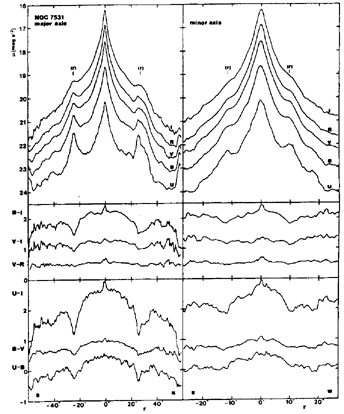
|
Detailed color index maps have been published for many ringed galaxies, including NGC 5364 (Schweizer 1976); NGC 4314 (Benedict 1980; Benedict et al. 1992); NGC 1433, 6300, and 7531 by Buta (1986b, 1987a, b); NGC 3081, 7020, 7187, and 7702 by Buta (1990a, b, c; 1991); NGC 1097 by Hummel et al. (1987); NGC 5728 by Schommer et al. (1988), 29 outer ringed and pseudoringed galaxies by Buta & Crocker (1991); NGC 4622 by Buta et al. (1992); NGC 6782 and IC 1438 by Byrd et al. (1994); NGC 3313, 7098, IC 5240 by Buta (1995), ESO 565-11 by Buta et al. (1995a), and NGC 7217 by Buta et al. (1995b). Wozniak et al. (1995) also presented B - I color index maps of a sample of galaxies having secondary bars or inner isophote twists.
A few representative cases are illustrated in Figure 34 and Figure 35. Most inner rings which have been studied are continuous blue enhancements, usually with imbedded discrete associations. Azimuthal variations in color index around a ring can be due to internal extinction, as in NGC 7531 and 7702, but can also be intrinsic as in nearly face-on galaxies such as NGC 1433, 3081, and 4622 (see Figure 36 for the latter two cases). In NGC 1433, the bright inner pseudoring is reddest in those regions immediately trailing the bar. In NGC 3081, however, the inner ring is bluest in arcs at its major axis, and is reddest near its minor axis points; this kind of variation undoubtedly reflects an intrinsic oval shape in the galaxy plane. In NGC 4622 (Buta et al. 1992), the bright inner ring is very blue on the west side, but quite red on the east side; this is atypical and could signify an interaction in this case.
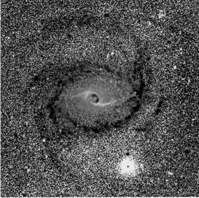
| 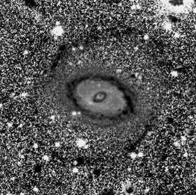
|

| 
|

|
Although most prominent nuclear rings are blue in color index maps, red nuclear dust rings have also been identified. Buta & Crocker (1991) pointed out the case of ESO 153-20, while Buta et al. (1995b), Wozniak et al. (1995), and Verdes-Montenegro et al. (1995) detected a nuclear dust ring in NGC 7217 (see Figure 37). Buta et al. noted that the latter ring lies on the inside edge of a neutral-colored stellar nuclear ring. Wozniak et al. also discovered a nuclear dust ring in NGC 521. Vila-Vilaró et al. (1995) discovered a partial nuclear dust ring in the Seyfert 1 galaxy NGC 4151. Higdon and Buta (1996) illustrate a nuclear dust pseudoring in NGC 5850.
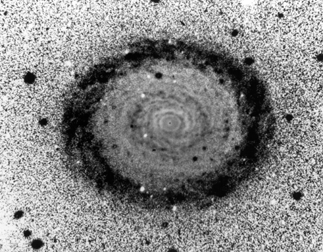
|
The star formation history of a few inner rings has been judged from color-color diagrams. Two approaches have been used. The first approach involves integrating fluxes in small circular apertures around a ring. No correction for the background light of the bulge and disk components is made, so colors in such apertures include an uncertain background contribution. In the second approach, total, background-corrected colors of a ring are obtained by computing an azimuthally-averaged surface brightness profile within an ellipse whose shape and orientation are the same as the ring, and interpolating a background-correction.
For NGC 1433 and 7531, Buta (1986b, 1987a) used the first approach. The color-color diagram for NGC 7531 is shown in Figure 38. For both NGC 1433 and 7531, the ring points scatter closely around the mean integrated galaxy sequence, which tells us that star formation has been more or less continuous in these features for a large fraction of the lifetimes of the galaxies. If the light were instead dominated by a single recent ``burst'' of star formation, the points would depart from the integrated galaxy sequence in a manner which would depend on the burst duration and strength, and also on the burst age (Larson & Tinsley 1978; Arimoto & Yoshii 1986; Leitherer & Heckman 1995). Thus, inner rings must be long-lived features in some galaxies that have had sufficient time to build up underlying old stellar components. Such an old component is evident in both NGC 1433 and NGC 7531.
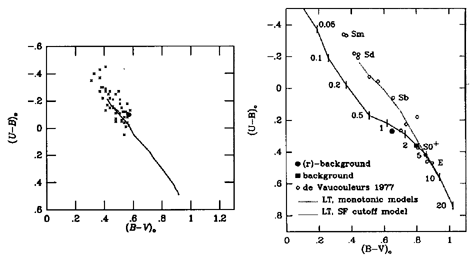
|
Buta et al. (1995b) used the second approach for the outer ring of NGC 7217. Two-color plots in the Cousins VRI system for the net colors of the outer ring are shown in Figure 39 (crosses). For comparison, the integrated color sequences of a large sample of normal galaxies (from Buta & Crocker 1992 and Buta & Williams 1995) are also illustrated (solid curves). The outer ring in this case has B - V and V - I colors bluer than the bluest late-type galaxies. Thus, the outer ring hump is dominated by a very young stellar population.
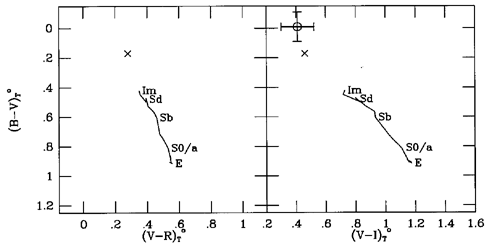
|
The second approach was also used for the inner ring of NGC 7702 (Buta 1991). The results for this one are shown in the right panel of Figure 38, where the filled circle is for the net colors of the inner ring, while the filled square is for the background underlying this ring. The additional curves in Figure 38 are for model galaxies either with monotonically decreasing star formation rates or a star formation cutoff, both from Larson & Tinsley (1978). Figure 38 shows that, while the background colors in the ring region lie close to the integrated galaxy sequence and the curve for the monotonic models, the net ring colors depart to the left of the sequence near the region where the age would be about 1-2 x 109 years in the star formation cutoff model. This suggests that the inner ring of NGC 7702 is a feature which experienced a last burst of star formation over one billion years ago, and has been evolving without much further activity ever since. Thus, star formation apparently can ``turn off'' in rings. In support of the aging ring scenario, Buta (1991) described how the net inner ring profile along the major axis of NGC 7702 can been represented very well by the sum of two gaussian components: a narrow, blue component and a broad, red component (see Figure 40). In the simplest interpretation, this is what would be expected of an aging ring where enhanced star formation has proceeded over a long time period. Stars born earlier in the ring would populate a broader zone than initially, while more recently formed stars would still lie near the narrower zone of gas compression.
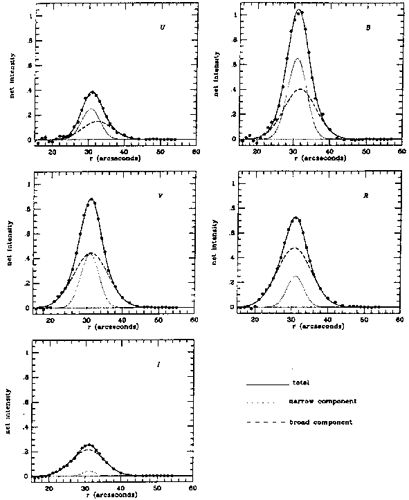
|
The colors of nuclear rings require considerable care to interpret.
The most extensive multicolor study of a nuclear ring was made by
Benedict et al. (1992),
who obtained optical and near-IR imaging of the
nuclear ring/spiral of NGC 4314. The nuclear ring was detected in all
color indices and is a site of recent star formation, being prominent
also at H and at
6cm. Comparing IR and optical colors, Benedict
et al. concluded that the nuclear ring is riddled with dust, some
relatively hot. The nuclear spiral part outside the ring, on the other
hand, showed evidence for an age progression, with the youngest stars
in the spiral being nearest to the nuclear ring. The colors of these
arms redden further away from the ring.
and at
6cm. Comparing IR and optical colors, Benedict
et al. concluded that the nuclear ring is riddled with dust, some
relatively hot. The nuclear spiral part outside the ring, on the other
hand, showed evidence for an age progression, with the youngest stars
in the spiral being nearest to the nuclear ring. The colors of these
arms redden further away from the ring.
Because the time-scales associated with nuclear rings are likely to be short (owing to their proximity to the nuclei of galaxies), they are more prone to bursts of star formation than inner rings. That this is likely to be the case stems from the wide range of color properties of such rings. In the most extreme cases, nuclear rings represent spectacular starbursts. The best-known example is that in NGC 1097 (Hummel et al. 1987). A less well-known example is that in ESO 565-11 (Buta & Crocker 1991; see Figure 15). The average background-corrected mean extinction-corrected colors of 8 associations in that ring is shown in Figure 39. The colors are consistent with model burst populations no more than 4-5 million years old according to the models of Leitherer & Heckman (1995). In contrast to these cases, there also exist nuclear rings where the color enhancement is weak (see Buta & Crocker 1991 for the examples of ESO 437-67, 507-16, among others), and still others, such as in NGC 5850, which are relatively neutral in color (Higdon et al. 1996), perhaps because of reddening, or perhaps because the ring is in a quiescent (post-burst) star forming phase.
Recent HST observations have elucidated the nature of star forming regions in nuclear rings. Barth et al. (1995, 1996) show that most nuclear rings contain bright, blue compact star clusters that usually suffer considerable extinction. The clusters are luminous enough to be called ``super star clusters'', a term first used for young clusters identified in starburst systems such as merger remnants (NGC 7252, Whitmore et al. 1993; 4038-9; Whitmore & Schweizer 1995) and amorphous irregulars (e.g., NGC 1705; Meurer et al. 1992). Barth et al. comment that nuclear rings are the only normal galaxy environment where such clusters are found in large numbers. The clusters may be young globulars, and Barth et al. suggest that they will probably be disrupted eventually, or absorbed by the nuclei of the galaxies due to dynamical friction.
In the case of most outer rings, colors are difficult to measure reliably owing to the typically very low surface brightnesses of such features. We have already discussed the previous observations of Schommer (1976) and Gallagher & Wirth (1980). The colors of outer rings in NGC 3081, 7020, and 7187 have also been measured, using CCD images (Buta 1990a, b, c). The mean corrected colors derived are (B - V) 0 = 0.61, 0.78, and 0.71 for NGC 3081, 7020, and 7187, respectively. Of these, NGC 7020 is the most interesting in that all of the recent star formation is taking place in the outer ring, as shown in the B - I color index map in Figure 35.